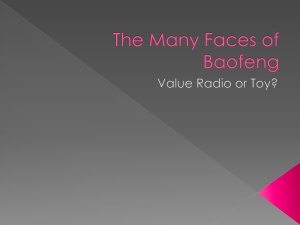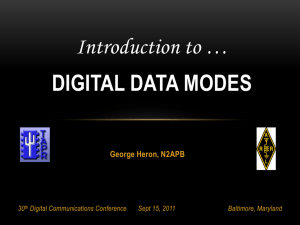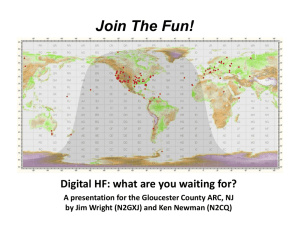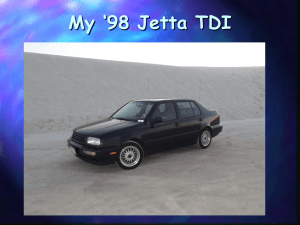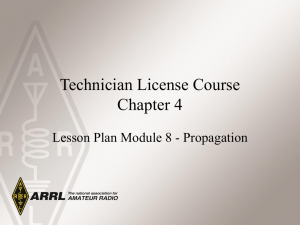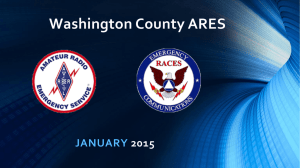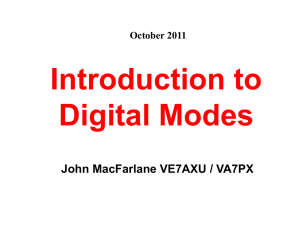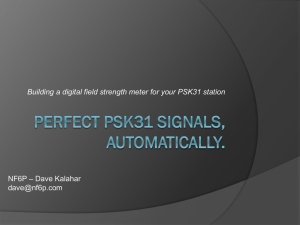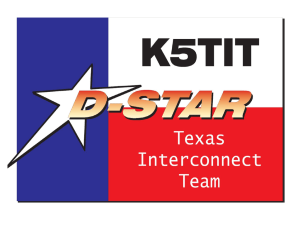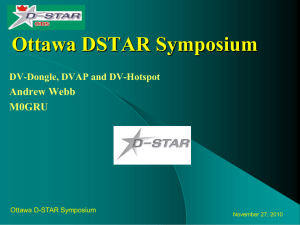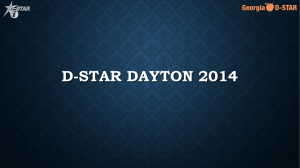2013-11-12 Digital Mode Update
advertisement
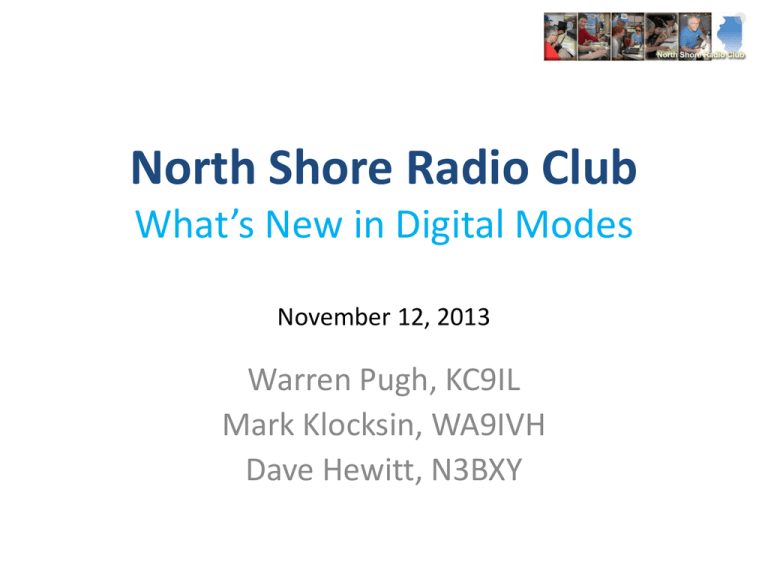
North Shore Radio Club What’s New in Digital Modes November 12, 2013 Warren Pugh, KC9IL Mark Klocksin, WA9IVH Dave Hewitt, N3BXY Agenda • • • • • Digital mode basics HF update VHF/UHF update Q&A Demonstration – FreeDV > HF digital voice – JT-9 > weak signal mode for HF/VHF/UHF 11/12/13 Digital Update - KC9IL 2 Digital Mode Basics - Hardware & software - Plus a little history 11/12/13 Digital Update - KC9IL 3 Digital Mode Basics • What is a “digital mode”? – At its basic level, it consists of two discontinuous states, “on” and “off”. – With a computer, “on” and “off” equate to 1’s and 0’s. – A Digital Mode transmits 1’s and 0’s by using a carrier. – Can create tones by sending carriers offset from a BFO frequency to represent data bits. 11/12/13 Digital Update - KC9IL 4 Digital Modes • In the beginning, there was: – Spark gap – CW (on-off with timing) – RTTY (offset carriers creating tones) – Facsimile (Hellschreiber) – Slow Scan TV 11/12/13 Digital Update - KC9IL 5 Digital Modes • Then (starting in the 80’s) came: – Packet (AX.25) • 300 baud on HF • 1200 - 9600 on VHF/UHF Hardware based modes – AMTOR (AMateur Teleprinting Over Radio) • HF - 100 baud, not much use currently – PACTOR – FSK mode combining Packet and AMTOR technology (still popular but fading) – G-TOR – proprietary to Kantronics. Rarely used. 11/12/13 Digital Update - KC9IL 6 Green = More mainstream • Next wave (1990’s & 2000’s) Software based modes – PACTOR II – 8x faster than PACTOR, proprietary – CLOVER – full duplex PSK mode – PSK31 – by Peter Martinez, G3PLX in 1998. Hugely popular. Also PSK63 & PSK128. – MT63 – DSP based, 64 tones, 100 WPM, wide. – THROB – DSP mode, 9 tones – MFSK16 – improvement on THROB, using 16 tones. 11/12/13 Digital Update - KC9IL 7 Digital Modes • More recent modes: Software based modes – Olivia – weak signal capable. 5 different flavors. • 125/4, 250/8, 500/16, 1000/32 & 2000/64 (BW/Tones) – JT-65 – weak & varying signals using 65 tones and FEC. Meteor scatter and moonbounce. – DominoEX – another weak signal MFSK mode, in six flavors. – Contestia – derived from Olivia. 2x speed. 5 bandwidths and 8 tone options = 40 variations. 11/12/13 Digital Update - KC9IL 8 Why Soundcard modes? • Soundcard (software) advantages: – Computers and soundcards are cheap, yet offer high performance – Lots of free software – Can be used with almost any radio – Easy to change digital modes – Developers can quickly create new modes – Lots of great logging options 11/12/13 Digital Update - KC9IL 9 How to set up a Digital Station Works for most non-proprietary modes * Darren Rook, KC9SSL, West Mountain Radio 11/12/13 Digital Update - KC9IL 10 Digital Mode Interfaces • • • • 11/12/13 Interface to any radio Isolated audio Rig control (CAT, CI-V, etc) Many now contain sound cards Digital Update - KC9IL KH6TY interface kit 11 Digital Mode Software • Unique: – Digipan – PSK31/63 – PSK31 – original software from G3PLX – MMTTY – RTTY – WSJT – JT65 by Joe Taylor, K1JT – JT65-HF by W6CQZ (improvement on original WSJT) – IZ8BLY Hellschreiber – all HELL modes – Stream – by IZ8BLY for MFSK 11/12/13 Digital Update - KC9IL 12 Digital Mode Software • Multimode: – FLDigi – for Windows, MAC OSX, Linux – Ham Radio Deluxe – most popular modes – Hamscope (PSK31, RTTY, ASCII, MFSK, Packet & CW) – MixW – multimode software developed in the Ukraine – MultiPSK - the Swiss Army Knife of soundcard mode software. Very busy user interface. 11/12/13 Digital Update - KC9IL 13 Criteria for Digital Modes • • • • RF bandwidth used Speed/data rate Error correction Reception at lower signal/noise ratio Can’t have it all, you must compromise! * Darren Rook, KC9SSL, West Mountain Radio 11/12/13 Digital Update - KC9IL 14 How the Modes compare Mode Lowest SNR Avg Speed @ 3KHz (WPM) Bandwidth (Hz) Error Correction 300 Baud Packet +3 dB 330 800 ARQ RTTY -5.5 dB 60 300 None MT63/500 -8 dB 50 500 FEC PSK31 -11.5 dB 51 80 None MFSK16 -13.5 dB 42 316 FEC JT-65A -26 dB 2.2 178 FEC 11/12/13 Digital Update - KC9IL * Darren Rook, KC9SSL, West Mountain Radio 15 HF Update - New modes - New Software 11/12/13 Digital Update - KC9IL 16 What’s New on HF? • New modes: – ALE 400 – JT 9 – LENTUS – WinMOR – WSPR – FreeDV – D-Star 11/12/13 Digital Update - KC9IL 17 Automatic Link Establishment (ALE) • Made for hands-free link establishment – Untrained operators (military and gov’t) – Scans available frequencies, picks the best one • Based on 1980’s era MIL-STD-188-141A (ALE141a) – 2 kHz bandwidth, 8 tone FSK) • Hardware based, cost prohibitive for hams 11/12/13 Digital Update - KC9IL 18 ALE 400 • Need to use MultiPSK software (only software with ALE support) • 400 Hz bandwidth • Internet e-mail gateway • 100% error-free (ARQ) full duplex link • Can use for real-time chat • dB rating and WPM will degrade due to retries. 11/12/13 Digital Update - KC9IL 19 ALE 400, continued Mode Lowest SNR (dB) Avg Speed BW (WPM) (Hz) Error Correc. PSK31 -11.5 51 None ALE141a ARQ FAE -6.5 to -8.5 120 to 246 2000 ARQ ALE400 ARQ FAE -11.5 to -13.5 56 to 107 ARQ 11/12/13 Digital Update - KC9IL 80 400 20 JT-9 • Refinement of JT-65 protocol developed by Joe Taylor, K1JT • About 1-2 dB better than JT-65, but can receive signals at – 42 SNR (30 minute mode) • Approximately 16 Hz wide, compared to approx. 178 Hz for JT-65 • Implemented in WSJT-X software. • Also uses time sync. (Dimension 4 or similar) • Cycles of 1,2,5,10 or 30 minutes 11/12/13 Digital Update - KC9IL 21 JT-9 • Seems to work as well on 5 watts as JT-65 does on 20 watts. Good for QRP or stealth! Mode Lowest SNR Avg Speed @ 3KHz (WPM) Bandwidth (Hz) Error Correction 300 Baud Packet +3 dB 330 800 ARQ RTTY -5.5 dB 60 300 None PSK31 -11.5 dB 51 80 None JT-65A -26 dB 2.2 178 FEC JT-9-1 -27 dB 2.2 16 FEC JT-9-30 -42 dB .07 0.4 FEC 11/12/13 Digital Update - KC9IL 22 JT-65 / JT-9 Spotting Web Page 11/12/13 Digital Update - KC9IL 23 LENTUS • Extremely weak signal contact, reception down to -35 dB • Experimental, part of MultiPSK software • 5 minute TX/RX cycles (approx 13 characters) • 32 tone MFSK, 23 Hz bandwidth. • PC clock synchronization is critical • Similar to JT-9 in long cycle modes. (JT9-5 is 34 dB). 11/12/13 Digital Update - KC9IL 24 WinMOR • Soundcard interface to Winlink 2000 • Replaces expensive packet radios traditionally used to connect to Winlink • Developed by Rick Muething KN6KB in 2008, deployment in 2010 • 500Hz or 1600Hz bandwidth • 67 to 1300 bits per second – Can exceed Pactor-2 rates 11/12/13 Digital Update - KC9IL 25 WinMOR to Winlink configuration 11/12/13 Digital Update - KC9IL 26 WSPR • • • • Weak Signal Propagation Reporter Joe Taylor K1JT It is not used for DX contact Software automates TX and RX of beacons which can the be viewed on wsprnet.org • Tool for determining band conditions • A beacon is TX or RX every 2 minutes. • Narrow band 4-FSK with RX at -28dB SNR 11/12/13 Digital Update - KC9IL 27 WSPR Recommended Software • WSPR – Joe Taylor K1JT – Windows and Linux • http://wsprnet.org – View beacon logs • Dimension D4 (or similar) – Time synchronization software 11/12/13 Digital Update - KC9IL 28 wsprnet.org 11/12/13 Digital Update - KC9IL 29 WSPR Screen Shot 11/12/13 Digital Update - KC9IL 30 FreeDV • Digital voice soundcard mode – Open source software and codec (based on FDMDV) – Written by David Witten & David Rowe – Response to low acceptance of AOR system, “proprietary” D-Star and IP concerns of FDMDV. • Released 2012, now in its 3rd version. • Designed to be analogous to SSB – 1.125KHz bandwidth (half of SSB) – 16 QPSK carriers, 1 BPSK carrier, 75hz spacing • High data rate, fast synch, low latency – 1600 bits/s (1375 b/s codec, 25 b/s call sign id, 200 bits/s FEC error correction) 11/12/13 Digital Update - KC9IL 31 FreeDV Setup You need a second sound card! * Darren Rook, KC9SSL, West Mountain Radio 11/12/13 Digital Update - KC9IL 32 FreeDV Software features • Windows, Linux, Mac, Android • Full record of QSO (both TX and RX) • Extensive audio filtering and processing (both TX and RX) • Turn off digital and run in analog (SSB) • http://qso.k7ve.org/ – QSO Finder Website 11/12/13 Digital Update - KC9IL 33 FreeDV QSO Finder 11/12/13 Digital Update - KC9IL 34 FreeDV screenshot 11/12/13 Digital Update - KC9IL 35 D-Star • Open protocol developed by JARL & Japan gov’t • Up until recently, only for 2 meters, 70 cm and 23 cm bands • HF and 6 meters only with 9600 baud capable radios, software and an AMBE chip (DV Dongle, MOEN Comm board, etc) • Now with Icom 9100 and 7100, full D-Star capability on HF. • Nets and QSO’s are now appearing on HF 11/12/13 Digital Update - KC9IL 36 What’s New on HF? • New software – PSK Reporter – (basically a reverse beacon) – Airlink Express – for PSK, MFSK and RTTY – WSJT-X – enhanced for JT-65 and includes JT-9 11/12/13 Digital Update - KC9IL 37 PSK Reporter • Automatic Propagation Reporter • Software automatically sends received QSO information to Internet server • http://pskreporter.info • Used for many modes, not just PSK • Compatible software – HRD, Airlink Express, JT65-HF, FLDIGI 11/12/13 Digital Update - KC9IL 38 PSK Reporter 11/12/13 Digital Update - KC9IL 39 Airlink Express • • • • • • Free, easy to use DX contact software Similar to Digipan Supports PSK, MFSK and RTTY Logging Multichannel display PSK Reporter compatibility 11/12/13 Digital Update - KC9IL 40 Airlink Express 11/12/13 Digital Update - KC9IL 41 WSJT-X • Updated version of WSJT, by Joe Taylor, K1JT • Vastly improved user interface from prior version (more like JT65-HF, by Joe Large, W6CQZ) • Needs time sync (Dimension 4 or similar) • Runs both JT-65 and JT-9 • Point and click operation • Split screen mode 11/12/13 Digital Update - KC9IL 42 WSJT-X 11/12/13 Digital Update - KC9IL 43 WSJT-X Can have JT-65 on this side 11/12/13 Can have JT-9 on this side Digital Update - KC9IL 44 Try these – they cost NOTHING! • New modes: • New software: – ALE 400 – JT 9 – LENTUS – WinMOR – WSPR – FreeDV – D-Star 11/12/13 – PSK Reporter – Airlink Express – WSJT-X Digital Update - KC9IL 45 VHF/UHF Update - Current overview - New equipment - Enhancements 11/12/13 Digital Update - KC9IL 46 Current Overview – VHF/UHF • Analog FM – been around nearly 50 years • Digital Linking (VoIP based) – IRLP – (1997 – by David Cameron, VE7LTD). Must have a radio at each end. – EchoLink – (2002 - by Jonathon Taylor, K1RFD) can have a radio, PC or smartphone at each end. • Currently over 200,000 registered users – Both formats support “reflectors” 11/12/13 Digital Update - KC9IL 47 Current Overview – VHF/UHF • Digital modes: – APCO Project 25 (P-25) • • • • • 11/12/13 Created in 1989 Intended for mission-critical applications Phase 1 equipment started showing up in the late ‘90’s Fairly small number of machines Can run dual mode (Analog & Digital) Digital Update - KC9IL 48 Current Overview – VHF/UHF • Digital modes: – D-STAR • • • • Developed by JARL & Japanese government Spec released in 2001 Icom began shipping in 2004 2 worldwide networks (approx 1500 repeaters) – Icom G2 » > 1,000 repeaters, > 30,000 registered users – ircDDB (Jonathon Naylor, G4KLX) » > 1,000 repeaters, 8,500 users 11/12/13 Digital Update - KC9IL 49 Current Overview – VHF/UHF • Digital modes: – DMR (Digital Mobile Radio) • Based on a European standard (ETSI) published in 2005 • Intended for professional use, low complexity & low cost, narrow band • Many manufacturers (Motorola, Hytera, Harris, Vertex) • Dual slot TDMA (Slot 1 linked, Slot 2 local) • MotoTrbo – Motorola’s implementation of DMR • Multiple linked networks (DMR-MARC, DCI, Trbo-6) – Nearly 400 repeaters as of Nov 2013 – Approximately 4,000 registered user ID’s 11/12/13 Digital Update - KC9IL 50 New VHF/UHF equipment – Icom D-Star radios with “DR” programming & GPS • To simplify programming IC-7100 HF/VHF/UHF all mode including D-Star ID-51 20meter / 70 cm handheld 11/12/13 Digital Update - KC9IL 51 New VHF/UHF equipment – D-Star ancillary products • • • • DV Dongle – access D-Star network from PC DVAP – low power remote base access point Raspberry Pi – Linux microcomputer AMBE encode/decode boards (MoenComm & similar) – Create repeaters & remote access without Icom hardware 11/12/13 Digital Update - KC9IL 52 New VHF/UHF equipment • New and used DMR equipment offerings 11/12/13 Digital Update - KC9IL 53 VHF/UHF Digital enhancements • D-Star – – – – Increasing number of “non-Icom” repeaters Experimentation with Raspberry Pi microcomputer Growth of “cottage industry” products “Tweaks” to G2 network (Redundant headers) • DMR – More sub-groups forming as user base grows – Regional, national, international – Automated Roaming 11/12/13 Digital Update - KC9IL 54 VHF/UHF Digital enhancements • ALLSTAR – Similar to IRLP/EchoLink, but network-centric as opposed to end-user centric – Supports multiple types of nodes: • Repeater, Simplex Remote Base, Hub – Uses Linux-based computers – At least 5 equipment “partners” – www.allstarlink.org 11/12/13 Digital Update - KC9IL 55 New VHF/UHF equipment • Yaesu’s C4FM/CDMA “System Fusion”– Sept 2013 – – – – 11/12/13 Not compatible with other digital modes 1 mobile, 1 portable Repeater in November 2013 No specifics on capability (routing, linking, etc) Digital Update - KC9IL 56 Questions? 11/12/13 Digital Update - KC9IL 57 Demonstration • FreeDV – open source digital voice protocol for HF (but can be used on VHF as well) • JT-9 – Error-correcting data mode fo VERY WEAK signal work – Moonbounce – Meteor scatter – Low power, limited antennas 11/12/13 Digital Update - KC9IL 58 So, What Should I Try? • HF – RTTY – popular, easy to get started – PSK31 – keyboard conversational – JT65/JT9 – not conversational. Test your limits! – Olivia or ALE 400 as you get more confident • VHF/UHF – D-Star – currently more mainstream (10x users) – DMR – growing quickly, good local Elmers – > NSRC has BOTH!!!! 11/12/13 Digital Update - KC9IL 59 References: • G4UCJ’s Radio Website http://hfradio.org.uk/html/digital_modes.html • WB8NUT - http://wb8nut.com/digital/ • Amateur Radio Transmitting Society (Louisville) – http://www.w4cn.org/about-ham-radio/digitalmodes • West Mountain Radio http://www.westmountainradio.com/ • http://jt65.w6cqz.org/receptions40.html 11/12/13 Digital Update - KC9IL 60 11/12/13 Digital Update - KC9IL 61
